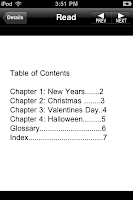I walked into one of our classrooms Tuesday morning and the teacher and students were all engaged in using the iPods. Third graders have recently been learning about the organizational features in expository texts, such as the Table of Contents and Index.
They were using the StoryKit app to create their own expository books with organizational features and had started these holiday books the previous day by creating their Title Pages. As I entered the room, they were working on a Table of Contents for the books. The teachers modeled and directed the students, taking comments and feedback from students as needed. They all gave some input as to the holidays they would include and the page numbers each should go on.
The following day they began adding content to the pages and drawing their own illustrations for the books. The teacher shared that is was so quiet in the room while they were working, you could hear a pin drop! When they are finished the teacher is going to have them record the narration for their books so they can share them with other students.
Here is an example of one student's work:
They were using the StoryKit app to create their own expository books with organizational features and had started these holiday books the previous day by creating their Title Pages. As I entered the room, they were working on a Table of Contents for the books. The teachers modeled and directed the students, taking comments and feedback from students as needed. They all gave some input as to the holidays they would include and the page numbers each should go on.
The following day they began adding content to the pages and drawing their own illustrations for the books. The teacher shared that is was so quiet in the room while they were working, you could hear a pin drop! When they are finished the teacher is going to have them record the narration for their books so they can share them with other students.
Here is an example of one student's work:






Comments
Post a Comment